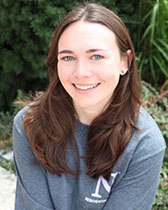Student Spotlight: Jessie Bolger

By Irena Garic
Where are you from or where did you grow up?
I grew up near Philadelphia, PA, but my family now lives in Boulder, CO. I moved during the summer between my sophomore and junior years of high school.
What made you decide to attend Northwestern University?
I am highly passionate about both chemistry and vocal performance, and I wanted a school that allowed me to pursue and balance both. I have loved engaging in the rigorous music and chemistry circles at Northwestern, and I have learned and improved so much in both disciplines.
What has been your favorite Chemistry class?
I got to take Analytical Chemistry 329, colloquially called ‘Story Time with (Professor) Van Duyne’ before he passed away. I loved learning about Professor Van Duyne’s discovery of surface-enhanced Raman spectroscopy (SERS), from the original entries in his lab notebooks and to his personal anecdotes. These narrative-style lectures truly vitalized the discovery process of analytical chemistry for me, whose broader societal applications can range from solar cells to the preservation of artistic paintings.
Is there a professor that has made an impact on your academic career?
Professor Zosia Krusberg was the only female professor I ever had for any of my science classes at Northwestern. Her wonderful teaching style not only helped me pass my physics class (and consequently enabled me to take my other chemistry major classes), but also taught me how to approach difficult scientific problems. By focusing on process and understanding why each step occurs, I have both improved and found more enjoyment in my scientific methodology and career path.
Tell us more about the research you conducted in Professor Tom O’Halloran’s Lab?
I have worked to solve the crystal structures of two allosteric control mutant variants of CueR, the Cu(I)-regulatory protein in E. coli. I have successfully crystallized and solved the structure of one variant, a Cu(I)-independent constitutive activator (CueRCA), and have made strides toward crystallizing another variant, a constitutive repressor (CueRCR). The structures of these variants can and have provided key evidence of the mechanistic details of transcription activation in the copper efflux system of E. coli. Since these key mechanistic properties are likely shared with other metalloregulators and ligand-binding proteins in eukaryotes as well as other prokaryotes, this research could prove very applicable to the binding of many different ligands with protein/DNA complexes.
What has been the highlight of your academic career thus far?
In 2018, I was selected as an Undergraduate Research Scholar by the Alumnae of Northwestern University. I designed my own independent research project to modernize an older operetta to a modern context, and both my proposal and work were very well-received. I loved designing and working on my project, and doing so inspired further confidence in myself for future endeavors, both vocational and avocational.
Where do you hope to be in your career in the next 10 years?
I hope to take on a more managerial position in the biotechnology industry, determining which products, drugs, or medical devices to pursue and develop. Over the next 10 years, I will gain a broader understanding of the decisions and strategies that go into the developmental research process, including gauging market needs and the promise of novel products and applications. I want to choose which directions to take chemistry and scientific innovation in order to tackle to most difficult and relevant biomedical challenges.
What is the first thing you will do after COVID-19 pandemic is over?
I will likely go to a bookstore and just linger, either by book browsing or reading books there in the shop. I miss lingering in public spaces without endangering the health of others, and as soon as it’s safe, I plan on lingering as unobtrusively as possible.
